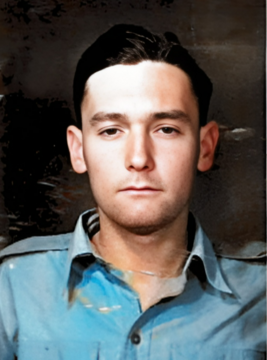
DAWKINS, Harry Blinman
| Service Number: | 280791 |
|---|---|
| Enlisted: | 4 March 1940 |
| Last Rank: | Flight Lieutenant |
| Last Unit: | No. 22 Squadron (RAAF) |
| Born: | Gawler, South Australia, Australia, 15 April 1917 |
| Home Town: | Gawler, Gawler, South Australia |
| Schooling: | Not yet discovered |
| Occupation: | Civil Servant - Clerk |
| Died: | Illness whilst a Prisoner of the Japanese, Talili, New Britain, Pacific Islands, 22 July 1944, aged 27 years |
| Cemetery: |
Rabaul (Bita Paka) War Cemetery, Papua New Guinea (CWGC) Burial Reference ~ Plot D, Row B, Grave 2. Personal Inscription ~ "HIS DUTY NOBLY DONE... EVER REMEMBERED" |
| Memorials: | Adelaide WW2 Wall of Remembrance, Australian War Memorial Roll of Honour, Ballarat Australian Ex-Prisoners of War Memorial, Gawler Council WW2 Honour Roll, Gawler RSL Memorial Wall |
World War 2 Service
| 4 Mar 1940: | Involvement Flight Lieutenant, 280791 | |
|---|---|---|
| 4 Mar 1940: | Enlisted Parafield | |
| 4 Mar 1940: | Enlisted Royal Australian Air Force, Flight Lieutenant, 280791 | |
| 26 Jul 1943: | Transferred Royal Australian Air Force, Flight Lieutenant, No. 22 Squadron (RAAF) | |
| Date unknown: | Involvement |
Help us honour Harry Blinman Dawkins's service by contributing information, stories, and images so that they can be preserved for future generations.
Add my storyBiography contributed by tony griffin
Flight Lieutenant Harry Blinman Dawkins
280791
Harry Blinman Dawkins was the son of Harry Blinman Dawkins and Elsie Maud Dawkins. Harry was born at Gawler on the 15 April 1917. His father Harry, who at the time of his death was secretary of the Adelaide Cricket Club, a delegate of the South Australian Cricket Association and secretary of the South Australian Baseball League, had died on 25 September 1916 at the age of 34.
Harry had completed his accountancy studies at the University of Adelaide in 1939 and was employed as a civil servant when, at the age of 22, he enlisted in the Royal Australian Air Force, at Parafield, on 4 March 1940. He was immediately posted to 1 Elementary Flying School at Parafield where initial pilot training was provided.
On 14 June he became engaged to Grace May Hissey, the daughter of Herman and Jessie Amelia Hissey of Sandy Creek, near Gawler. Harry was posted to 1 Service Flying School at Pt. Cook for flight training on 29 July. Here a variety of aircraft including Anson, Wapiti, Tiger Moth, Demon and Avro Trainers were used to provide advanced flying training. On 24 September Harry was promoted to Pilot Officer and on 18 November transferred to 1 Air Observers School at Cootamundra to be trained in bombing and gunnery. During this time Harry had been promoted to Flying Officer.
While on leave at Christmas Harry and Grace were married.
On 8 September 1941 Harry moved to Central Flying School at Camden, New South Wales. At this time Grace moved back to Gawler where their first son, John Nicholas, was born on 28 September. For the young family a move back to South Australia would have been most welcomed. Harry joined 6 Service Flying Training School at Mallala on 15 December and would remain based there for eighteen months. In April 1942 he was promoted to Flight Lieutenant.
At 5 Operation Training Unit at Forest Hill, Wagga Wagga recently graduated pilots were converted from advanced trainers to combat aircraft, and added fighting abilities to the flying skills they had already learned. Harry served in 5OTU from 9 May 1943 until 22 July, training firstly on Beauforts and then on Bostons. On 24 July he joined 22 Squadron on Goodenough Island, New Guinea.
Harry would pilot his Boston Bomber A28-15 with his crew consisting of Sergeant Douglas George Semple (Wireless Air Gunner) from Strathalbyn and Sergeant Gordon Ronald Thomas (Wireless Air Gunner) from Croydon. This Boston had flown about 51 combat missions before Harry took command. On the right side of the nose was the nickname "Spirit of Sport" atop a shield divided into four quarters with a woman, cards, beer mug and smoking items including a pipe, cigar, and cigarette with filter tip. On the left side of the cockpit was nose art with a Japanese head being hit by boomerang.
Harry’s first flight was a bombing run over the Japanese airfield at Gasmata on 23 August, followed by three more on the 29 August, 4 September and 5 September. On the fourth flight A28-15 received a shrapnel hit which put a hole in the rudder. The next operation was to search for the crew of a ditched Beaufighter on 10 September. On September 12, 1943 Harry took off from Vivigani Airfield on Goodenough Island on a mission over Gasmata on New Britain. Over the target, the aircraft was damaged by anti-aircraft fire and ditched into the sea. Harry and his crew members were observed to board a life raft apparently uninjured. The observing aircraft had to leave the area soon after the ditching, but extensive searches were later carried out with no successful result.
It was later discovered that Semple died on that day and Thomas was captured by the Japanese and transported to Rabaul where he was detained at Tunnel Hill POW Camp. On March 5, 1944 Thomas was selected as one of thirty-one Allied prisoners who were led away and executed during the Talili Bay Massacre (Tunnel Hill Massacre). Harry was also captured by the Japanese and detained at Tunnel Hill. Here he died of beri beri and dysentery on July 22 1944.
Harry’s remains were later discovered and he was buried in the Rabaul (Bita Paka) War cemetery in Papua New Guinea.
Harry and Grace’s second son, Peter Harry, was born on 28 December 1943.













